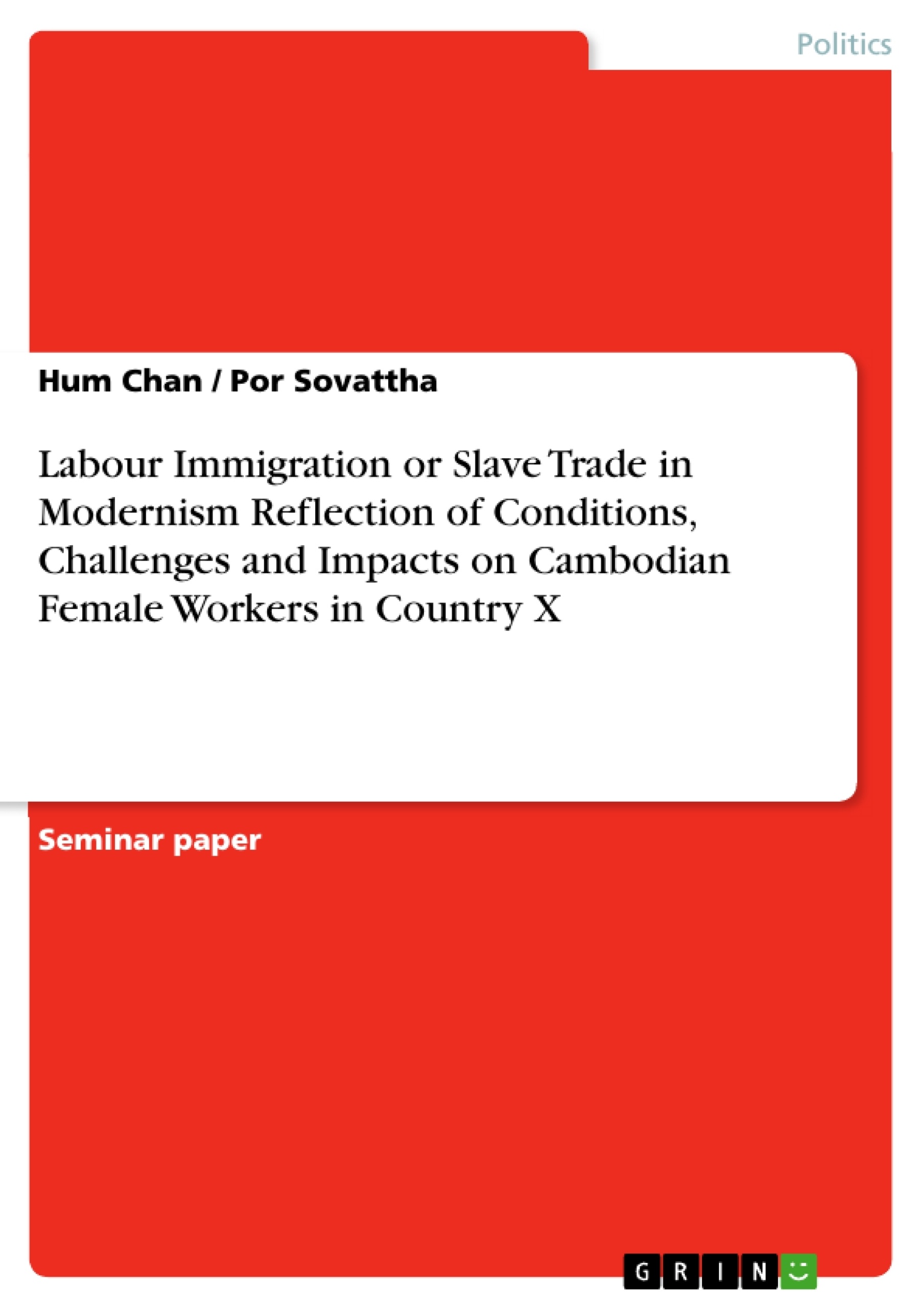Abstract
This paper aims to define the status of Cambodian female workers in terms labour immigration or slave trade in modernism. Especially, the study identifies the employment conditions, challenges and impacts in country of destination X in South East Asia. Data was predominately descriptive nature extracted from documents and video interviews. A direct analysis was employed to discuss this issue. The results identified that Cambodian female workers migrated to work in country X under a legal immigration system, however, the workers were trafficked and exploited, forced to work overload, physically mistreated, sexually and emotionally abused by the employers. Consequently, they were psychically suffered and economically impacted caused aggravate poverty. Some workers died during working without appropriate legal actions. In conclusion, Cambodian female workers become victims of modern labour trade under a legal procedure. The finding from this study suggests further strengthening cooperation and intervention from countries of origin and destination is a mechanism to integrate regional economy.
Keyword: Labour Immigrant, Slave Trade, Modernism, Cambodian Female Workers
Abstract
This paper aims to define the status of Cambodian female workers in terms labour immigration or slave trade in modernism. Especially, the study identifies the employment conditions, challenges and impacts in country of destination X in South East Asia. Data was predominately descriptive nature extracted from documents and video interviews. A direct analysis was employed to discuss this issue. The results identified that Cambodian female workers migrated to work in country X under a legal immigration system, however, the workers were trafficked and exploited, forced to work overload, physically mistreated, sexually and emotionally abused by the employers. Consequently, they were psychically suffered and economically impacted caused aggravate poverty. Some workers died during working without appropriate legal actions. In conclusion, Cambodian female workers become victims of modern labour trade under a legal procedure. The finding from this study suggests further strengthening cooperation and intervention from countries of origin and destination is a mechanism to integrate regional economy.
Keyword: Labour Immigrant, Slave Trade, Modernism, Cambodian Female Workers
Introduction
Globalization and economic transition has adversely impacted on socioeconomic and livelihood of people in the developing countries in South-East Asia, particularly Cambodia. The influx has pushed Cambodian people, especially women and girls, to make risky decision looking for better job opportunities oversea. After Cambodian and Malaysian government signed Labour Export Agreement in 1997, a large numbers of women workers have been recruited (Maltoni, 2006). Recently, Human Right Watch (2011) claimed that around 50,000 women and girls were sent to Malaysia for work. The process of immigration has been carried out through brokers and agencies who promise to give safe, well-paid and high incentive job to workers.
Regardless legal and illegal immigrants, several reports identified that Cambodian female workers were trafficked and being exploited by employers (Lee, 2007). According to ADHOC (2012), victims filed 141 complaints for reasons of poor work conditions such as overwork with very little rest time, untreated illness, torture, underpayment, being detained, and cut-off family contact. Even worse, some female workers were raped and killed in Malaysia (Press Release JUMP, 2012). The issue has become a grave concern to both countries as labour immigration is a new mechanism to alleviate poverty of regional countries. Therefore, the purpose of this article is to find out a scenario of Cambodian female workers whether has been operated in a form of labour immigration or slave trade in modernism. To reach this objective, a question is posed “What are the employment condition, challenges, and impacts in the country of destination?”
Labour Immigration vs. Slave Trade
Labour immigration refers to the legal process of sending and receiving people from one to another country for employment purpose. The process must follow government policies, labour law, and immigration legal system. The Regional Thematic Working Group on International Migration including Human Trafficking (2008) defined labour immigration as more recent and integral parts of political economy in South East Asia Region. By contrast, slave trade is a human trafficking which is against laws and human rights. In modern age, slave trade occurs in the form of labour exploitation and sexual orientation inside a country and cross-border countries (Asia Regional Cooperation to Prevent People Trafficking (ARCPPT), 2003).
Overview of Cambodian Population
Currently, Cambodia has an estimated 14.5 million population with an annual growth of 2.4%. About 80% of Cambodian are farmers living in rural areas, only 12% living in Phnom Penh. Cambodia has a notable growth of youth with median age 21.3 years considered as the highest in the region. Annually, there are 300,000 Cambodian youth enter employment market. This number will sharply increase in the future. The increase has due to poverty, landless, narrow job opportunities and low paid in the country of origin.
- Quote paper
- Lecturer Hum Chan (Author), Por Sovattha (Author), 2013, Labour Immigration or Slave Trade in Modernism Reflection of Conditions, Challenges and Impacts on Cambodian Female Workers in Country X, Munich, GRIN Verlag, https://www.grin.com/document/208745
-

-

-

-
Upload your own papers! Earn money and win an iPhone X. -

-
Upload your own papers! Earn money and win an iPhone X. -

-
Upload your own papers! Earn money and win an iPhone X. -

-
Upload your own papers! Earn money and win an iPhone X. -

-
Upload your own papers! Earn money and win an iPhone X. -

-
Upload your own papers! Earn money and win an iPhone X.

